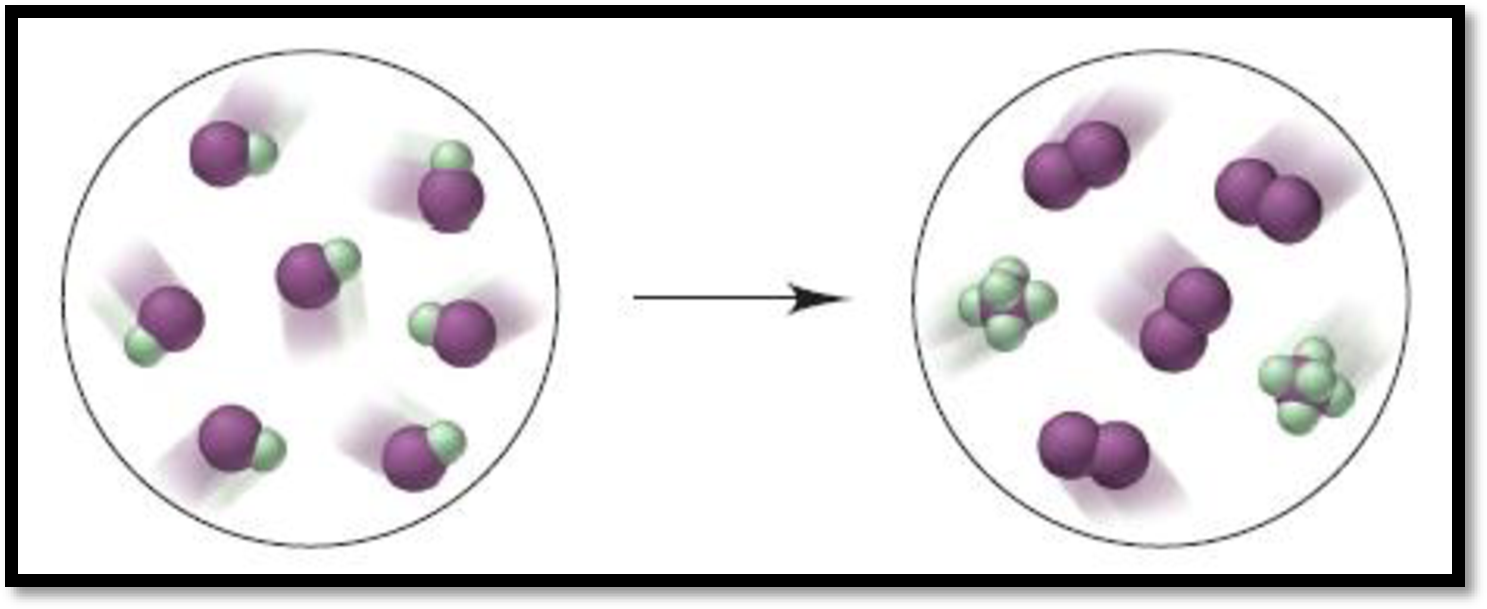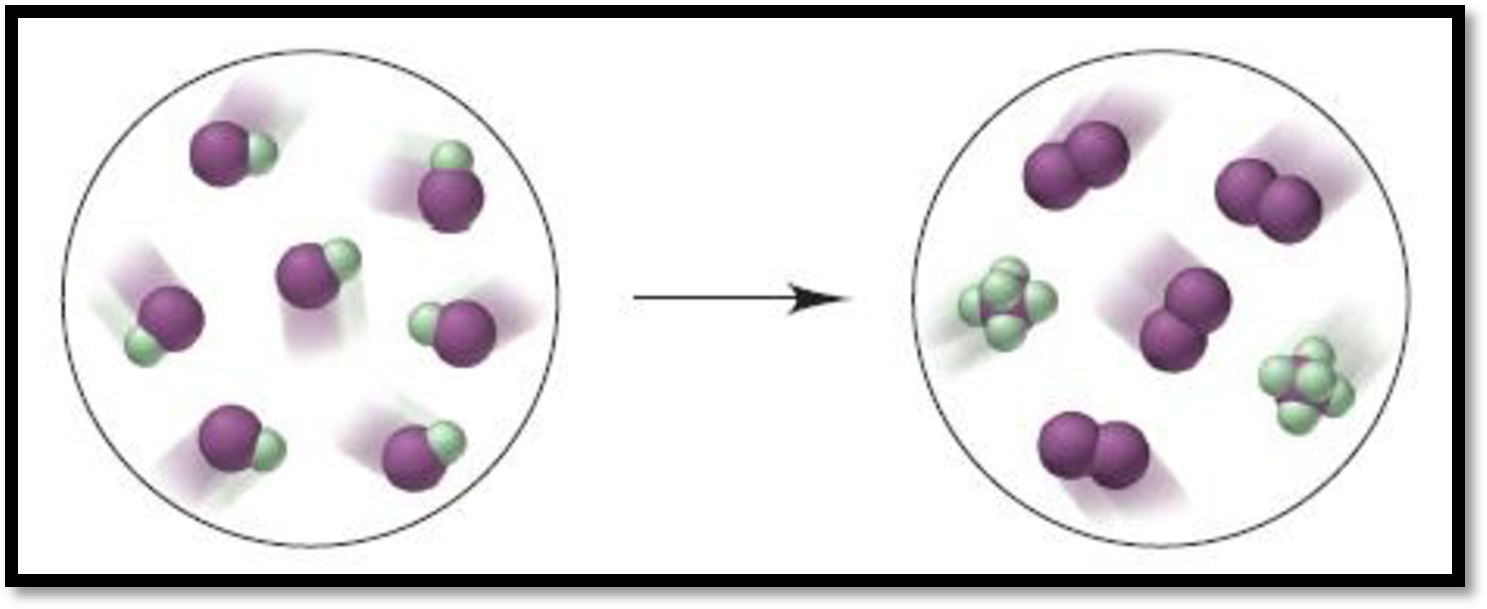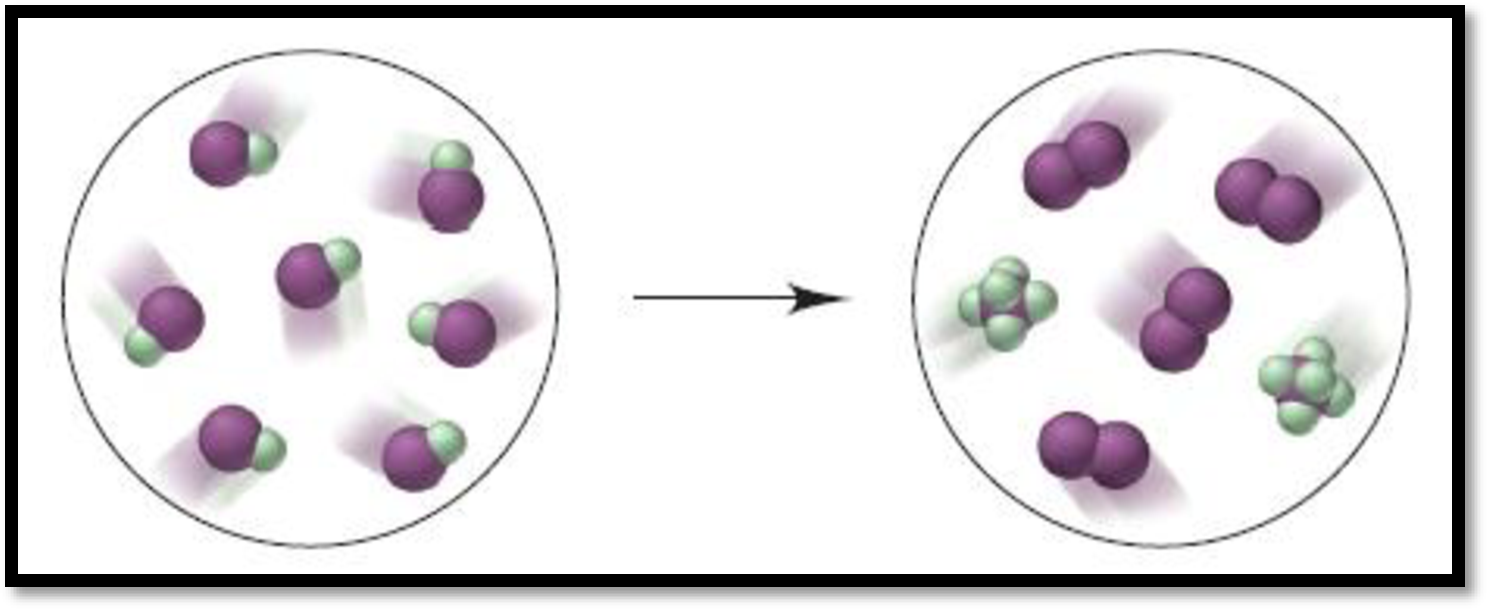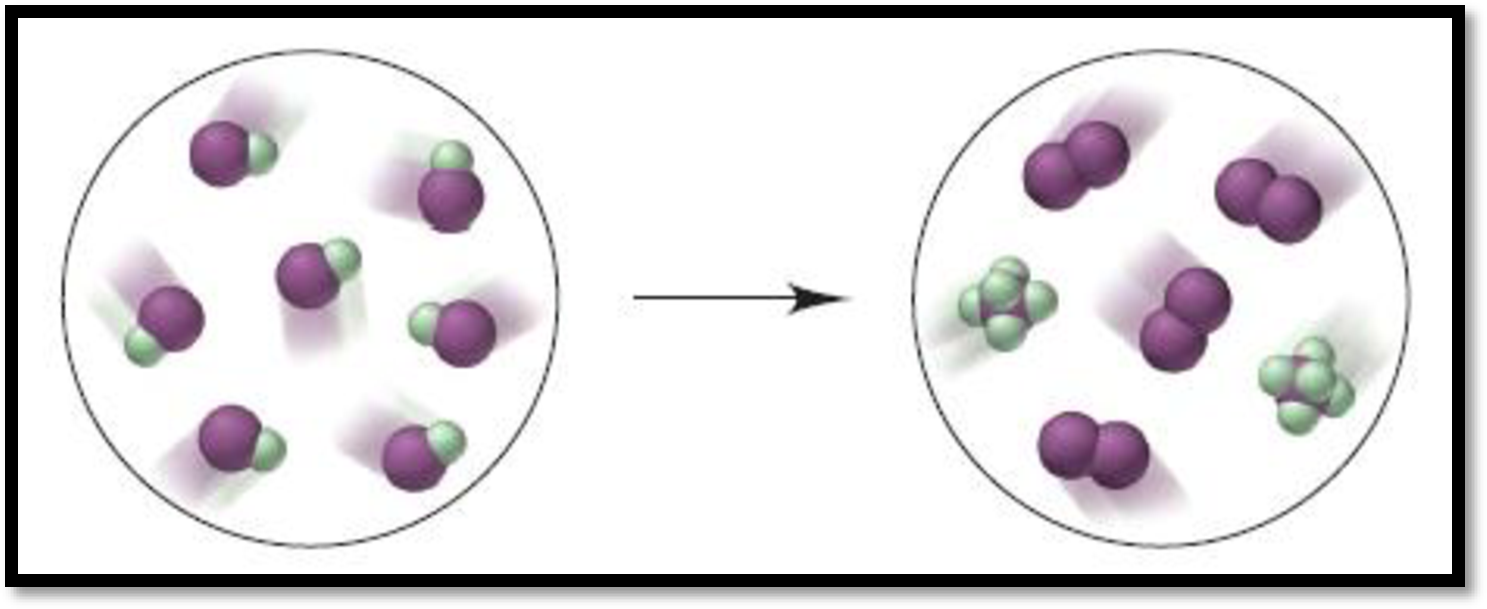
Concept explainers
(a)
Interpretation:
The equation for the reaction of interhalogen
Concept Introduction:
Interhalogen compounds:
The compounds which are only composed of two different halogens are known as Interhalogen.
Disproportionation
The formation of products of oxidized and reduced substances from a simultaneous redox reaction of single reactant is known as disproportionation redox reaction.
(a)
Explanation of Solution
Given depiction is,

Figure 1
From the given depiction, brown colour = iodine and green coloured are Fluorine atoms.
Therefore, the depiction refers the formation of
Hence, the balanced equation for the give reaction is,
(b)
Interpretation:
Name of the product of given redox reaction of
Concept Introduction:
Disproportionation redox reaction:
The formation of products of oxidized and reduced substances from a simultaneous redox reaction of single reactant is known as disproportionation redox reaction.
Interhalogen compounds:
The compounds which are only composed of two different halogens are known as Interhalogen.
(b)
Explanation of Solution
Given depiction is,

Figure 1
From the given depiction, brown colour = iodine and green coloured are Fluorine atoms.
Therefore, the depiction refers the formation of
The balanced equation for the give reaction is,
Product of above reaction is Iodine penta-fluoride.
(c)
Interpretation:
Name of given redox reaction of
Concept Introduction:
Disproportionation redox reaction:
The formation of products of oxidized and reduced substances from a simultaneous redox reaction of single reactant is known as disproportionation redox reaction.
Interhalogen compounds:
The compounds which are only composed of two different halogens are known as Interhalogen.
(c)
Explanation of Solution
Given depiction is,

Figure 1
From the given depiction, brown colour = iodine and green coloured are Fluorine atoms.
Therefore, the depiction refers the formation of
The balanced equation for the give reaction is,
Therefore, the above reaction shows given reaction is disproportionation reaction.
(d)
Interpretation:
Mass of product that formed from
Concept Introduction:
Disproportionation redox reaction:
The formation of products of oxidized and reduced substances from a simultaneous redox reaction of single reactant is known as disproportionation redox reaction.
Interhalogen compounds:
The compounds which are only composed of two different halogens are known as Interhalogen.
Mole:
Mole of substance that present in taken mole of sample is calculated by mass of substance is divided by molar mass of the substance.
(d)
Explanation of Solution
Given depiction is,

Figure 1
From the given depiction, brown = iodine and green = Fluorine atoms.
Therefore, the depiction refers the formation of
The balanced equation for the give reaction is,
Therefore, the above reaction shows given reaction is disproportionation reaction.
Mass of
Molar mass of
Mass of
Molar mass of
Hence,
Want to see more full solutions like this?
Chapter 14 Solutions
CHEMISTRY:MOLECULAR NATURE...-ALEKS 360
- For each reaction below, decide if the first stable organic product that forms in solution will create a new C-C bond, and check the appropriate box. Next, for each reaction to which you answered "Yes" to in the table, draw this product in the drawing area below. Note for advanced students: for this problem, don't worry if you think this product will continue to react under the current conditions - just focus on the first stable product you expect to form in solution. NH2 CI MgCl ? Will the first product that forms in this reaction create a new CC bond? Yes No MgBr ? Will the first product that forms in this reaction create a new CC bond? Yes No G टेarrow_forwardFor each reaction below, decide if the first stable organic product that forms in solution will create a new CC bond, and check the appropriate box. Next, for each reaction to which you answered "Yes" to in the table, draw this product in the drawing area below. Note for advanced students: for this problem, don't worry if you think this product will continue to react under the current conditions - just focus on the first stable product you expect to form in solution. དྲ。 ✗MgBr ? O CI Will the first product that forms in this reaction create a new C-C bond? Yes No • ? Will the first product that forms in this reaction create a new CC bond? Yes No × : ☐ Xarrow_forwardPredict the major products of this organic reaction: OH NaBH4 H ? CH3OH Note: be sure you use dash and wedge bonds when necessary, for example to distinguish between major products with different stereochemistry. Click and drag to start drawing a structure. ☐ : Sarrow_forward
- Predict the major products of this organic reaction: 1. LIAIHA 2. H₂O ? Note: be sure you use dash and wedge bonds when necessary, for example to distinguish between major products with different stereochemistry. Click and drag to start drawing a structure. X : ☐arrow_forwardFor each reaction below, decide if the first stable organic product that forms in solution will create a new C - C bond, and check the appropriate box. Next, for each reaction to which you answered "Yes" to in the table, draw this product in the drawing area below. Note for advanced students: for this problem, don't worry if you think this product will continue to react under the current conditions - just focus on the first stable product you expect to form in solution. NH2 tu ? ? OH Will the first product that forms in this reaction create a new CC bond? Yes No Will the first product that forms in this reaction create a new CC bond? Yes No C $ ©arrow_forwardAs the lead product manager at OrganometALEKS Industries, you are trying to decide if the following reaction will make a molecule with a new C-C bond as its major product: 1. MgCl ? 2. H₂O* If this reaction will work, draw the major organic product or products you would expect in the drawing area below. If there's more than one major product, you can draw them in any arrangement you like. Be sure you use wedge and dash bonds if necessary, for example to distinguish between major products with different stereochemistry. If the major products of this reaction won't have a new CC bond, just check the box under the drawing area and leave it blank. Click and drag to start drawing a structure. This reaction will not make a product with a new CC bond. G marrow_forward
- Including activity coefficients, find [Hg22+] in saturated Hg2Br2 in 0.00100 M NH4 Ksp Hg2Br2 = 5.6×10-23.arrow_forwardgive example for the following(by equation) a. Converting a water insoluble compound to a soluble one. b. Diazotization reaction form diazonium salt c. coupling reaction of a diazonium salt d. indacator properties of MO e. Diazotization ( diazonium salt of bromobenzene)arrow_forward2-Propanone and ethyllithium are mixed and subsequently acid hydrolyzed. Draw and name the structures of the products.arrow_forward
- (Methanesulfinyl)methane is reacted with NaH, and then with acetophenone. Draw and name the structures of the products.arrow_forward3-Oxo-butanenitrile and (E)-2-butenal are mixed with sodium ethoxide in ethanol. Draw and name the structures of the products.arrow_forwardWhat is the reason of the following(use equations if possible) a.) In MO preperation through diazotization: Addition of sodium nitrite in acidfied solution in order to form diazonium salt b.) in MO experiment: addition of sodium hydroxide solution in the last step to isolate the product MO. What is the color of MO at low pH c.) In MO experiment: addition of sodium hydroxide solution in the last step to isolate the product MO. What is the color of MO at pH 4.5 d.) Avoiding not cooling down the reaction mixture when preparing the diazonium salt e.) Cbvcarrow_forward
 ChemistryChemistryISBN:9781305957404Author:Steven S. Zumdahl, Susan A. Zumdahl, Donald J. DeCostePublisher:Cengage Learning
ChemistryChemistryISBN:9781305957404Author:Steven S. Zumdahl, Susan A. Zumdahl, Donald J. DeCostePublisher:Cengage Learning ChemistryChemistryISBN:9781259911156Author:Raymond Chang Dr., Jason Overby ProfessorPublisher:McGraw-Hill Education
ChemistryChemistryISBN:9781259911156Author:Raymond Chang Dr., Jason Overby ProfessorPublisher:McGraw-Hill Education Principles of Instrumental AnalysisChemistryISBN:9781305577213Author:Douglas A. Skoog, F. James Holler, Stanley R. CrouchPublisher:Cengage Learning
Principles of Instrumental AnalysisChemistryISBN:9781305577213Author:Douglas A. Skoog, F. James Holler, Stanley R. CrouchPublisher:Cengage Learning Organic ChemistryChemistryISBN:9780078021558Author:Janice Gorzynski Smith Dr.Publisher:McGraw-Hill Education
Organic ChemistryChemistryISBN:9780078021558Author:Janice Gorzynski Smith Dr.Publisher:McGraw-Hill Education Chemistry: Principles and ReactionsChemistryISBN:9781305079373Author:William L. Masterton, Cecile N. HurleyPublisher:Cengage Learning
Chemistry: Principles and ReactionsChemistryISBN:9781305079373Author:William L. Masterton, Cecile N. HurleyPublisher:Cengage Learning Elementary Principles of Chemical Processes, Bind...ChemistryISBN:9781118431221Author:Richard M. Felder, Ronald W. Rousseau, Lisa G. BullardPublisher:WILEY
Elementary Principles of Chemical Processes, Bind...ChemistryISBN:9781118431221Author:Richard M. Felder, Ronald W. Rousseau, Lisa G. BullardPublisher:WILEY





